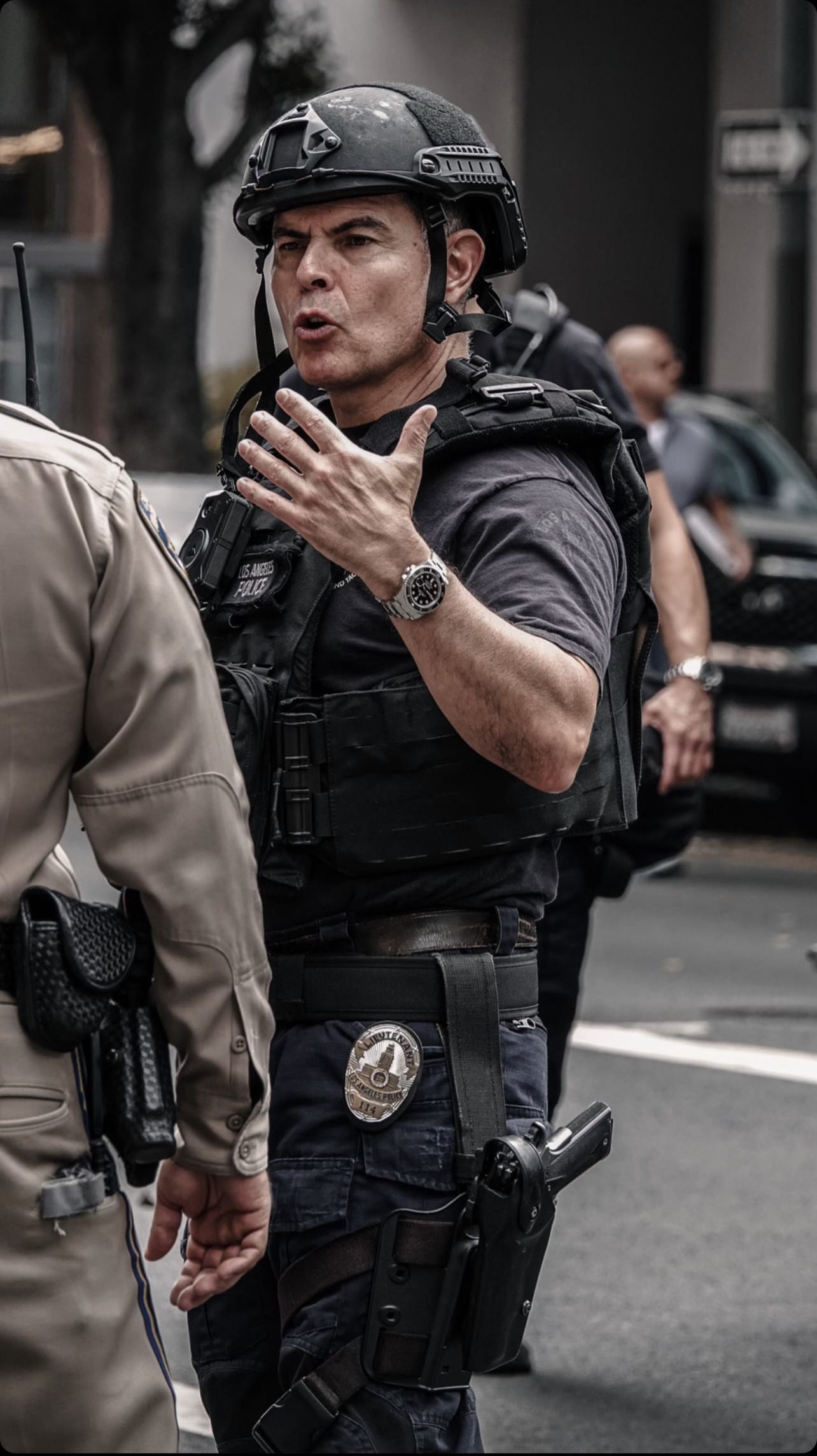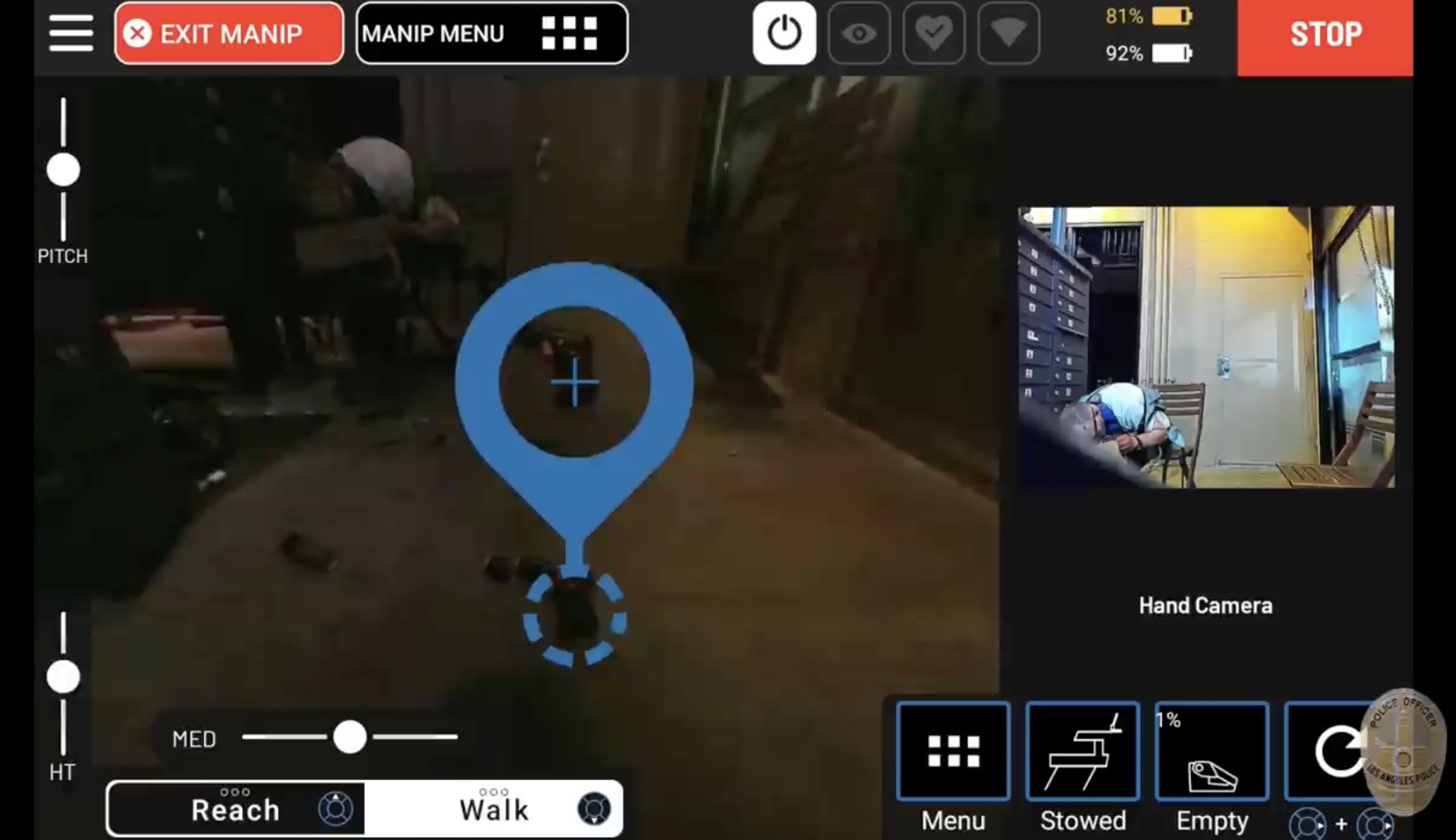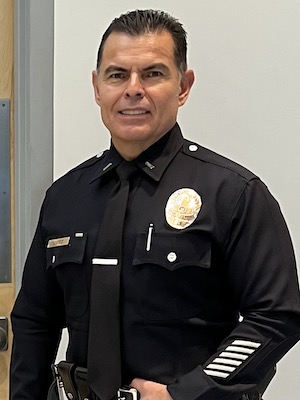GOOD DOG?
Meet Spot: LAPD’s new canine-like quadruped robot. Police say it will enhance officer safety, but opponents fear its impact on vulnerable communities.
By Alexandra Goldberg
On a warm November afternoon at the Los Angeles Police Department Metropolitan building in Westlake, Lieutenant Ruben Lopez and the LAPD SWAT team took their new dog, Spot, for a walk around the parking garage. It knew its commands: sit, stay, release and even shake. But this was no average canine.
Spot, with its 3 feet long, 17 pound arm, is a robot.
The LAPD received Spot in May from the Los Angeles Police Foundation, a not-for-profit organization that supports the LAPD. It’s a donation valued at nearly $278,000. The robot manufactured by Boston Dynamics is equipped with an arm that can open doors and grasp objects, and an infrared camera that can analyze weapons. Police say the technology has been deployed twice and isn’t weaponized. Its latest mission was on a Metro bus in Hollywood on Nov. 8.
According to police, the LAPD can’t fund much of the police equipment for the city without the Los Angeles Police Foundation. Because the robot dogs aren’t earmarked in the city budget, a Restricted Grant Donation was requested nearly two years ago and passed in May. The Los Angeles Police Foundation denied a repeated request for comment.
Watch Spot come out of its kennel, and how some LA residents are responding.
Harm v. safety
Despite the LAPD’s push to support officer safety with this new technology, some LA residents are worried.
On March 7, LA resident Camile Lewis, dressed in a black-and-yellow Black Lives Matter jacket and “F— the Police” hat, took to the podium in the Los Angeles City Council chamber. “We know exactly who this new tech is going to be targeting,” she said in a speech that was live streamed on Facebook.
“We know exactly who this new tech is going to be targeting.”
— Camile Lewis
The sign she was holding, with the words “Bark, Bark” printed in thick black letters, further indicated her fears about the Los Angeles Police Department’s new robotic technology.
Later, after Lewis shouted from her seat at the end of the public comment period, she was removed from the chamber and then arrested at city hall for disrupting the meeting.
City Council President Paul Krekorian issuing the removal of protestor Camile Lewis from the chamber on March 7 for disruption of the meeting. (Credit: Los Angeles City Council)
Lewis said she frequents LA City Council meetings as a Black Lives Matter LA activist. In May, just days after the council voted 8-4 to approve the donation of an Quadruped Unmanned Ground Vehicle — the robot dog — she was again arrested in city hall on suspicion of assault. Lewis said she did nothing wrong, and that police randomly want to arrest protestors.
“There's one thing about being concerned that my rent is going to be raised,” Lewis said. “And another that LAPD is going to mow you down with assault weapons with a robot dog.”
Lopez, the officer in charge of the LAPD’s SWAT team, said the new tech is all about officer safety.

Lieutenant Ruben Lopez, SWAT Officer in Charge, on duty in Los Angeles. (Credit: Ruben Lopez)
“The whole point of this is to de-escalate, where we are not putting human beings in a situation with an armed suspect who is either under the influence, mentally ill, suicidal or wanted for crime,” he said.
Lopez added that just 16 officers in the SWAT team are trained to deploy the robot. The situation has to meet strict criteria before Spot is called on the scene. If the suspect is armed with a weapon, wanted for a crime or in an inside location and refusing to submit to arrest, officers may get approval to use the robots.
“There’s no tasers, lasers, bullets, nothing like that,” he said of the robot dog.
Boston Dynamics did not respond to several requests for comment about Spot’s capabilities with weapons.
The LAPD’s Metropolitan Division facility was originally the “bunker-like” LAPD Rampart Station, which was transformed in 2016 to a hub for several units including the SWAT team, the K-9 unit and home to the robotic police dog, Spot. The walls are lined with a mural of the division’s crest, valorous plaques and a memorial frame for Randal Simmons. On this day, Led Zeppelin's “Stairway to Heaven” played quietly from a cubicle on the first floor.
Simmons was killed in 2008 during a standoff with an armed suspect in the San Fernando Valley — the first SWAT officer to be killed in the line of duty. Lopez said his death was the “genesis” for having technology like Spot in high-risk situations.
“If I can avoid having to notify a wife again, or looking at a wife and saying he's not coming home, this is why and this will help — these types of tools and technology,” Lopez said.
Boston Dynamic's quadruped robot, Spot, has popped up around the globe for uses even beyond policing. Interact with the map to see Spot's worldwide deployments.
Despite assurances from the LAPD and Boston Dynamic, residents like Lewis are skeptical. “This is really dystopian to me,” she said. “It’s very 2050,” she added.
She also fears disproportionate impacts on vulnerable communities.
“So they're probably going to do it where there's a lot of vulnerable people, low income people, Black and Brown people, disabled people, people suffering mental health crises,” Lewis said. “That's where they're going to use the dogs.”
Lopez refuted this by saying SWAT goes where the calls are. “We go where the violent crime is,” he said. “And unfortunately, It happens all over every part of the city.”
He also said the robot dog doesn’t go off on its own. “There's still the human element and control,” he said.
“Robot dogs scare me,” said Stephen “Cue” Jn-Marie, pastor of Church Without Walls on Skid Row and founder of Creating Justice LA. “And they scare me in the hands of an already brutal institution.”
“We've basically just made it slave catching in the future.”
— Stephen "Cue" Jn-Marie
The community activist and faith-rooted organizer said he’s informed by his background in policy making. Despite the LAPD’s promise of harm reduction to the community, Jn-Marie said all it takes is a group of people to push policy for expanded uses of the robot dog in the future.
According to Jn-Marie, the policing system in America is toxic, stretching back to slave-catching forces active before the Civil War. “What's the difference between the dogs that used to run after enslaved people who are striving to get free and these robot dogs?” he said. “We've basically just made it slave catching in the future.”
Boston Dynamic's quadruped robot, Spot, is controlled on a tablet operated by a select few SWAT officers. (Credit: Alexandra Goldberg)
Spot in action
Los Angeles resident Taylor Sanders, 35, was the first suspect to encounter LAPD’s robot dog. Spot’s first deployment was during a Koreatown shootout on Aug. 12. Lopez said the unhoused person had an airsoft pistol and ended up behind a stairwell in between two packed restaurants. A second object was present, and after deploying Spot, police could view camera footage being recorded by the robot and streamed on an Android tablet to analyze it from afar.
“Is that even a pistol? It looks like a lighter,” said one police officer in body cam footage from the encounter.
The second object was confirmed to be a lighter. Police officers on the scene were able to communicate with the suspect through a speaker on the robot, and Lopez said the suspect eventually complied and Spot was able to retrieve the airsoft pistol.
“A human being would’ve had to go up there,” Lopez said. “This view is from behind cover and you’re not exposed… we want to avoid a violent confrontation whenever possible.”

A view from afar: SWAT officers watch real-time camera footage from a tablet. (Credit: LAPD)
One officer in the technology cadre, a group in the SWAT team trained to operate robotics, said Spot helps with officer safety much more than the older wheeled or track robots in their inventory.
“It’s just a night and day difference in opening doors which allow us to clear a location and look for a possible suspect from a safe distance, keeping ourselves as well as the suspect safe,” said Gregory Martin, police officer III + I for Metropolitan division SWAT Team.
Spot's second deployment was in Hollywood on Nov. 8. The SWAT team said they received a radio call about an individual asleep in a Metro bus with a gun, unresponsive. Lopez said once the individual woke up, he was compliant with authorities.
“The use of this technology resolved the situation without putting officers or community members in harm's way,” the LAPD Public Information Officer said in a statement on X, formerly known as Twitter.
A gripper attached to Spot's arm has the ability to autonomously open doors. (Credit: LAPD)
Experts weigh in
Ashley Johnson, senior policy manager at the Information Technology and Innovation Foundation (ITIF), said that with cutting-edge police tech, like Spot, there are three major concerns: data privacy, the use of taxpayer dollars and a skeptical public.
Johnson hosted a police tech panel on Jan. 11, which included Brendan Schulman, Vice President of Policy and Government Relations at Boston Dynamics.
“It's a little bit of a dystopian skepticism too often,” Schulman said about public perception of the robots during the panel. “Our product cannot be weaponized, it can't be used to harm or intimidate a person or an animal.”
Johnson said one major question surrounding robot or drone use is about the potential for harm on a greater scale than without technology. “Because they amplify the potential capabilities of a police department, could they also amplify the potential for harm to individuals?” she said.
On weaponization, Johnson said most manufacturers, including Boston Dynamics, have a policy prohibiting weapons on robots or drones. “I could definitely see that changing if states or the federal government passes a law or regulations that would give a written-in-law, codified set of rules on the circumstances when you can weaponize a robot or a drone,” she said. But currently, there is a blanket generalization against weaponization.
Weaponization: All bark, no bite?

Ruben Lopez / LAPD

Camile Lewis / BLM LA

Cue Jn-Marie / pastor

Ashley Johnson / ITIF
Johnson said moving forward, there needs to be regulations to clear up uncertainty and a clear set of rules on uses such as weaponization, data collection and training.
“The fact that each individual police department can set policies for themselves creates a lot of uncertainty both for the companies and for individuals living in communities that have law enforcement,” she said.
Johnson also noted that the adoption curve of high-tech robots like Spot is going to be far slower than people expect because of the price tag. “Most police departments in America are just small, local police departments that don't have that much money,” she said.
But Lopez was confident there would be an expansion of quadruped robots in the division. He said the addition of other quadrupeds would likely come from federal grants available for security measures. “We have the Olympics coming, the subway system is growing, the current situation in the Middle East, it’s not going to get better,” he said.
He also said he’s unsure if the robots will be used in other LAPD patrol forces because officers must go through a strict training regimen, and he doesn’t know if other patrol forces can support the intense training.
“They're not toys,” Lopez said. “It's not playtime.”

